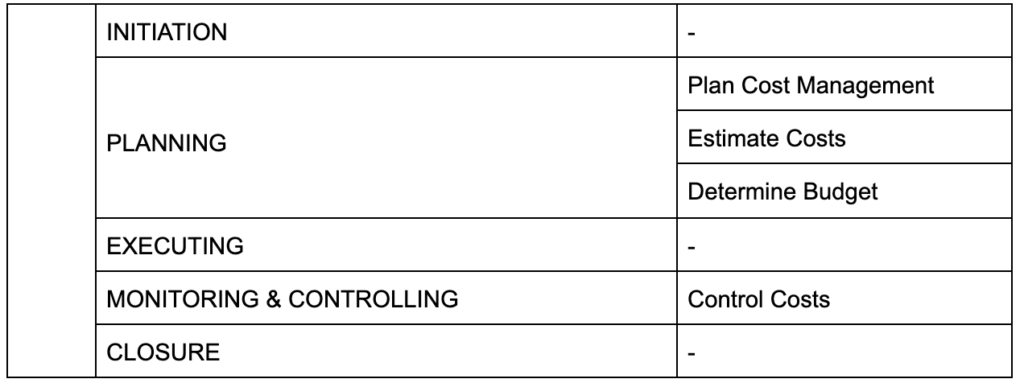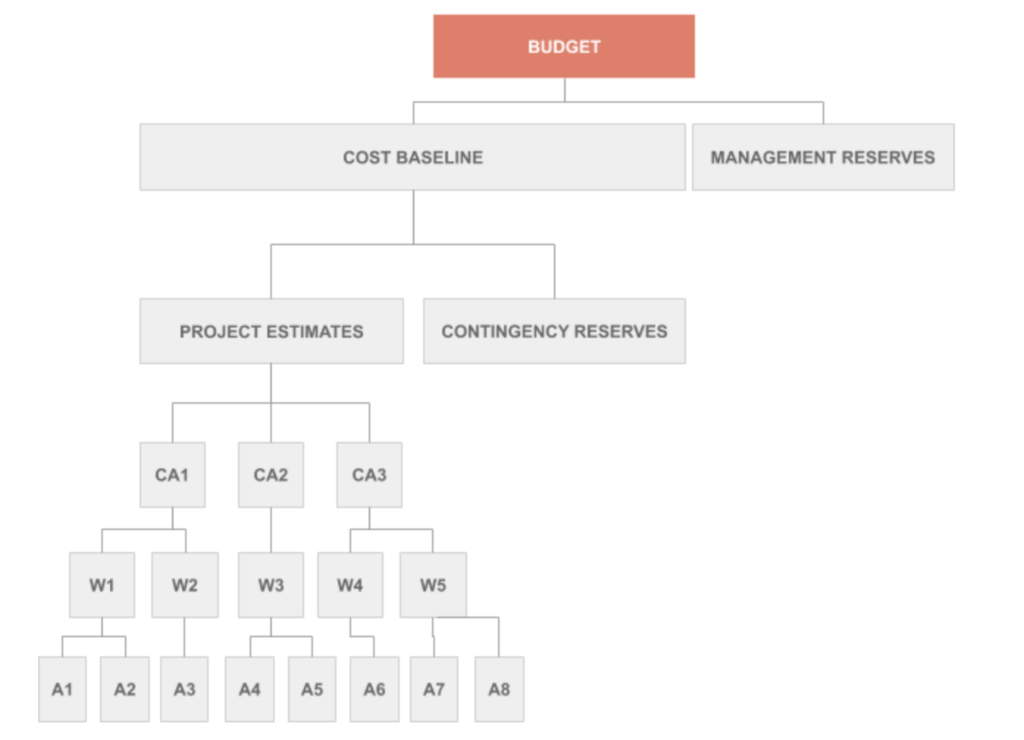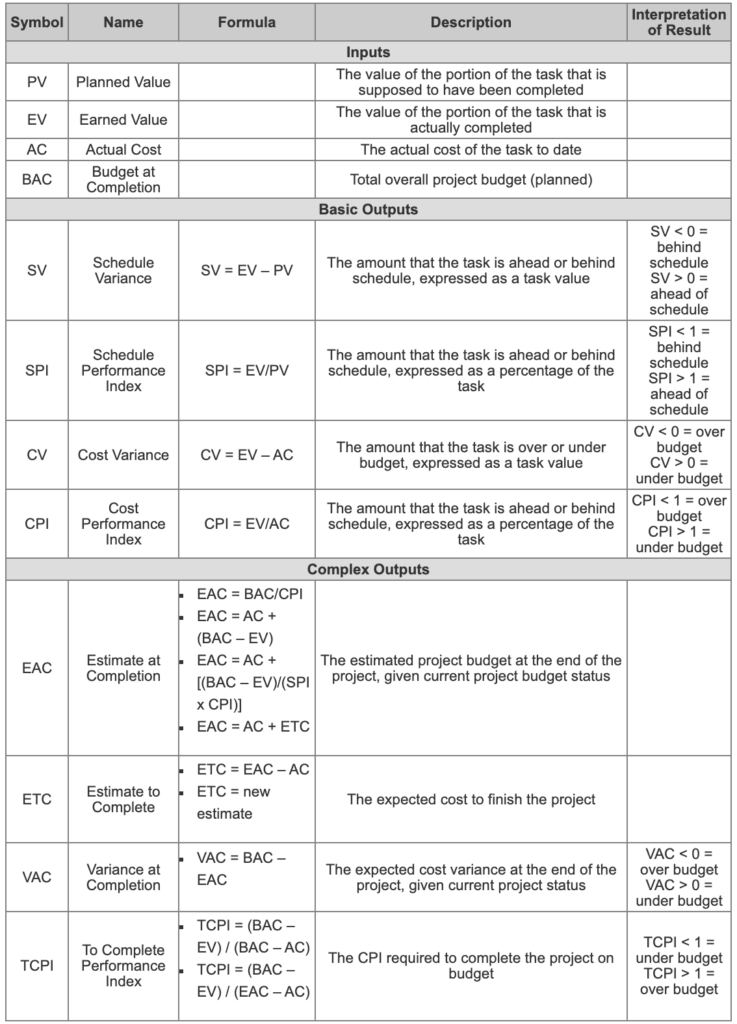| You are a Project Manager for construction of the library in Manhattan. You realise that there are 15 quite-rooms to be built at a cost $50,000 each however you noticed that after spending 180,000 you had been able to built just 3 rooms. You estimated the cost of the RCC cement to be 1000 per quintile however during the construction, the prices racked up and you didn’t have that accommodated in your budget. Despite calculating the budget in advance, the cost is deviating and you have no strategy or plan to encounter that |
Project Cost: The budget for completion of all the work of the project and relative activities involved along with the reserve is known as the project cost.
If you went through the Scope Management and Schedule Management notes, you will realise that cost management is much similar and quite easy to understand.

Phase: PLANNING Knowledge Area: COST MANAGEMENT
The process describes how you are going to plan, monitor and control your budget throughout the project lifecycle. And also manage the cost variance that may creep in.
The Project Cost Management decides the project will be funded by company funds or equities/debts. Moreover, the financial decisions shall also be included in this; like purchase or rent.
Multiple factors can be helpful for the Cost Management Plan like ROI (Return on Investment), NPV (Net Present Value), Payback Period etc those were covered in Integration Management.
COST MANAGEMENT PLAN: The Plan Cost Management has one major output which is Cost Management Plan. Similar to all other management plans, the Cost management Plan also merges into Project Management Plan. The cost Management Plan includes various aspects of managing cost like:
Accuracy of Estimates: This is the threshold level of correctness of the estimates, and as the name suggests. The accuracy very much depends on various factors like, proper planning, timelines for estimation etc.
At times the boss asks the PM to give a timeline for creating a blog. This is vague approach hence the PM has to answer then & there so he shares 300 Hours; which is called Rough Order of Magnitude (ROM). The ROM is accurate from -25 to +75% which means the cost to develop the blog can be 25% less than estimated to 75% more than the estimate. This is quite faster way of estimation but also highly inaccurate. There are other approaches like bottom-up approach etc that can be read in Schedule Management.
Budget Estimate: Even before the iteration is planned, it is good to maintain a budget that ranges from -10 to +20% variance.
Definitive Approach: During the project planning phase, all aspects are considered, hence the estimates are done in planning which is accurate up to 士10%.
Phase: PLANNING Knowledge Area: COST MANAGEMENT
The estimate costs as the name suggests is the estimation of all the activities required throughout the project lifecycle.
Before we dive into further cost planning & estimating, we must need to understand what all types of cost exist in the project:
Based on the nature of cost that may or may not fluctuate, the costs are:
Considering the costs based on their impact the project, the costs can be divided into:
PMIS: The PMIS or Project Management Information System is the PM software used by the project team to better track and monitor the project management. This could be used to create WBS, documentation, collaboration etc. However the PMIS itself cannot handle the project as it is just a software.
Alternative Analysis: As mentioned in schedule management, there are times when the budget is to be controlled hence the PM needs to search for alternatives to bring the project on track with the costs.
Reserve Analysis: The reserve is basically the padded amount kept aside by the PM to deal with the known risks, that is contingency reserve. While, in order to deal with the unknown risks, the management has some reserves called Management Reserve that PM has no control over.Cost of Quality: The additional cost added in order to meet certain quality standards is called Cost of Quality.
Phase: PLANNING Knowledge Area: COST MANAGEMENT
After the various costs are considered in previous processes, it is crucial for the project manager to create budget of the complete project so as to request the funds for the project.
In order to determine the entire budget of the project, the PM needs to take into account the cost of all the work packages, contingency reserve, management reserve etc.

Once the budget is determined, the Project Manager may use expert judgement to allot the budget for relevant areas of work such as some organizations provide 20% cost to design, some software firms provide 40% budget for testing. This depends on the project manager to refer the historical data, project requirements, organization process etc to determine the same.
Post this, there is a need to check on the cashflow. In case there is a need to purchase a license for the software needed in project however the money to buy that license is not available for a month, then the project manager needs to re-align the work packages that are dependant on the licensed software.
Phase: M&C Knowledge Area: COST MANAGEMENT
There is not much difference between controlling costs as compared to any other control process like control schedule or scope. Basically control cost refers to ensure the costs are aligned as per the plan.
So how do you ensure that cost is intact ? Well, there are a few concepts that will be helpful:
Earned Value Analysis: One of the most important concepts in cost is EV Analysis. This is the performance measurement used for performance review for the cost, scope, and schedule baselines.

For more quick reference of the formulas, please refer to the Formulas of PMP in detail.
Reserve Analysis: If you consider in last process of determining budget, we had a contingency reserve. Suppose, we estimated a risk that could affect the project and hence kept the reserve for that. However; the project is in full swing and the risk does not occur and thus this reserve is not needed. So the project manager should remove this reserve. Or otherwise, if there are new risks identified, the project manager may add new reserves.
Progress Reporting: The progress of the project needs to be constantly monitored against fixed parameters to understand if the work is on track. The PM can refer to the WBS and check for the work packages and determine the progress using that as a reference.